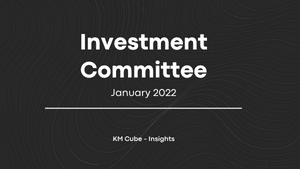
Investment Committee – January 2022
On occasion of the new year, the Investment Committee discussed its more long-term outlook for the markets and its major concerns going forward. Global stock markets closed 2021 at, or near, their all-time highs – that much we know. Consequently, equity volatility remains compressed and the system periodically lets off some steam through sporadic crises that are shallow and short-lived. Courtesy of major central banks, asset prices are supported via accommodative policies that directly dictate institutional capital allocation and indirectly steer corporate capital aimed for productive purposes.
By keeping interest rates low, what central banks do is essentially increasing the supply of money. They increase the supply of money to a degree in excess of productive demand. Our view is that there’s so much cheap money around that investors literally do not know what to do with it. Hence many are buying into companies that are actually losing money, or purchase land lots on which you cannot build anything of significant utility. By doing so, the central banks are misallocating – and thereby perhaps even destroying? – capital. In theory, return on capital should always clear to the price and quantity of money. Interest rates should be determined by productivity and utility, with the real price of money being where these two optimize. But demand is currently channeled either to assets – hence lifting their prices relative to GDP – or into end-goods – thus lifting their prices relative to the utility they create.
Our conclusion going forward is that this is the essence for material inflation for the coming years; but the verdict is still on whether that would be even higher than current market expectations. The Committee discussed lengthily the case of gold as an inflation hedge that would probably react more positive through the next inflation period than it has during the recent mini crises of the past couple of years.
Price discovery mechanisms
KM Cube Investment Committee expressed the view that by determining the price of money, governments have removed what is called price discovery. That is, our ability as investors to determine whether something is cheap or expensive. This inability of price discovery from professional empirical and theoretical verification applies across all levels of the economy. By setting the narrative, central banks today outline what we should do and what we should purchase. An actual example was brought to the table: Is Tesla creating capital or destroying it? Although the stock price has skyrocketed and has evidently made its shareholders rich, the Committee questioned how equity prices trade at peak uncharted territory against the level of US Gross National Product. The majority of its members agreed on the enduring primacy of the US market and maintained its opinion on focusing on the S&P500 index as the driver behind the global exchanges’ steam-engine.
The main side-effect of loss of price discovery is that most direct investments in the stock exchanges are now passive. Passive investing does not require identifying individual attractive opportunities and just go for buying the index. Since the S&P500 index is a capitalization-weighted index, funds from passive investing are allocated to the biggest firms, who then become even bigger and thus attract more funds.

It also suggested how value stocks may outperform growth stocks in the next cycle and our firm is now preparing to launch a proposed list on quality high-dividend paying stocks. Our research team is already maintaining a value list on a monthly basis in our interactive tools platform.
Imbalances and the extremes
At the moment, social and political costs of these imbalances that central banks have created are far less than the cost of clearing them. This means we have lots of time to go, possibly even adding more imbalances, taking valuations to more extremes, before the system will eventually clear. As preventing the system clearing these unproductive policies to a more optimal level can only be done by government increasing its control further, we are effectively being governed by the imbalances.
Rate hikes in 2022
That said, the Committee is unanimous in expecting US$ interest rates to start rising this year. The Federal Reserve narrative is allowing investors to make clear predictions of its intentions, and the market today prices-in a total of three interest rate hikes within 2022, all of which by 0.25%.
We have no reason to expect something different.

Going further out the term-structure of US$ benchmark interest rates, governing members of the Federal Reserve board have casted their votes for the level of rates for the next few years, and the results serve well as the most illustrative prediction going forward. Each yellow dot represents a member’s estimate and provides the best guideline for where the central bank is driving interest rates.

So although we realize the caveats going forward, we believe a major correction is not a 2022 event.
We remain optimistic for our core strategies and believe the two flagship products of the firm (Unicorn and Global Navigator Fund) are actually best positioned to harvest the most of the market environment for 2022.